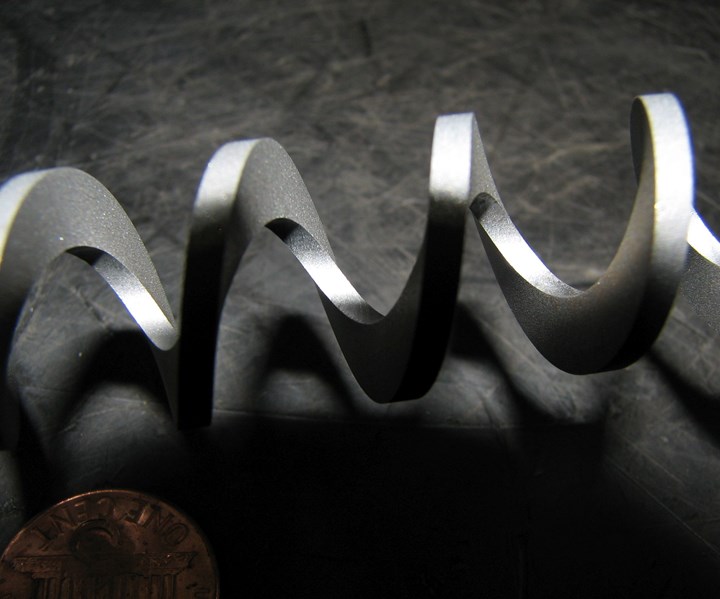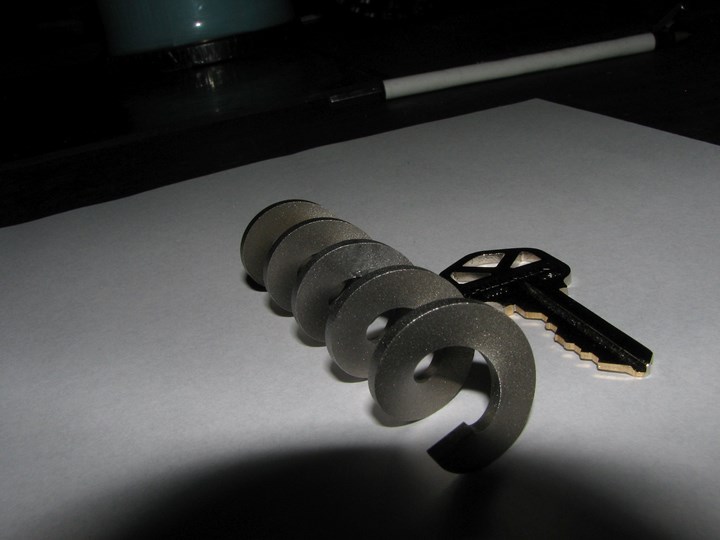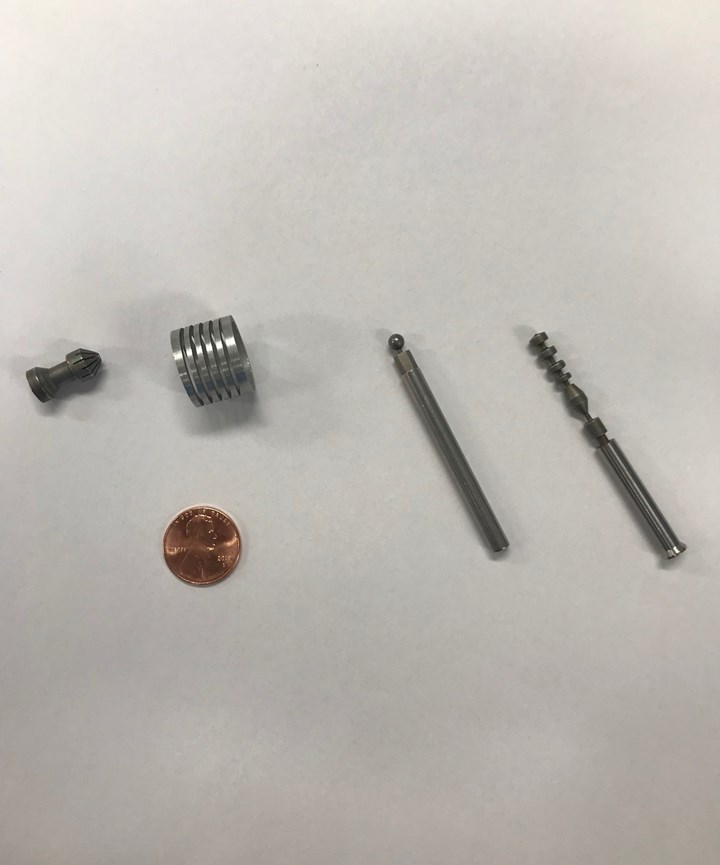Investment in Advanced EDM Equipment Sets Shop Apart With Unique Wire EDM Capabilities
Extreme Wire EDM capitalizes on technology investment to carve out competitive advantages serving the moldmaking industry.

Brothers Karl Bernt, president, and Brian Bernt, vice president, of Extreme Wire EDM Services Inc. (Grandville, Michigan) maintain a focus on the latest EDM technologies that will differentiate them from the competition. Not only does the company own the largest wire EDMs in the United States, it has two of them and the extra-large AgieCharmilles CUT P 1250 wire EDMs from GF Machining Solutions are in constant use. Since taking delivery of the first of these machines in July 2016 (before it was unveiled publicly by GF Machining a year later — see MoldMaking Technology’s September 2017 issue), they have set the company on a path to continued success. But this strategic investment was not the first the company has made that would help to attract new and different customers.
“We have always worked to ensure that we have other means for driving revenue when main markets we serve fall soft,” Brian Bernt says. “Our expertise is in wire EDM, so we look for products that will advance that expertise and potentially open new avenues for growth.” They found two products from Carl Hirschmann Inc. (Schaumburg, Illinois) that did just that: The H80R.MNC Rotary Indexing Spindle and the H80R.NCF Rotary Index/Turn-While-Burn unit. These auxiliary devices enabled Extreme Wire EDM to develop nearly unrivaled capabilities, speed delivery on jobs involving complicated geometries, reduce the number of setups and create cost savings for the company and its customers.
Wire EDM Lathing vs. Traditional Lathing
Bernt says using the H80R.MNC Rotary Indexing Spindle for wire EDM lathing offers notable advantages over machining using a traditional lathe and Extreme has two units. “We do a lot of special core pins that may have stepped or cone shaped features on the tips,” he says. “Conventional lathing tends to apply too much pressure and heat to these parts and cause warping. Also, it is nearly impossible to machine the special features required because the features are too small for a cutter. For example, the radii of internal features we have lathed have been as small as 0.004 inch.” He adds that if there are features to the side of those needing to be lathed, it may be doubly hard to get into the area with a traditional lathing tool. “When using wire instead of conventional lathing, there is no force or pressure being put on the part because it is the electrical field around the wire doing the machining. As the unit spins the workpiece (like core pins) at high speed, the wire never actually touches the part; and there is no heat because the water is temperature controlled via constant flushing of water around it.”
How does it work? The stainless steel constructed H80R.MNC unit measures about 10.43 inch by 8.35 inch by 4.72 inch and is set horizontally onto the wire EDM table and connected to the EDM’s power via its external control unit which operates the motor, encoder and tool clamper. It is run via an M-code that is driven by a 24-volt signal. According to Bernt, the Turn and Burn unit runs independently of the wire EDM but it does have one cord that is hard wired into the EDM. “For indexing, we can put a single line of code into our wire program which sends that code to the Turn and Burn unit,” he explains. “That code can only tell the unit to move to the next program line that is programmed into the external control. It is what tells the unit to index the workpiece without our having to manually do it.”
The face plate on the front of the unit accommodates several different tool clampers, including adapters if needed, and it rotates or indexes the workpiece as programmed by the EDM operator. In 2016, the company introduced a new model, the H80R.MNC.M01, featuring a new, internally located brush design comprising hundreds of thousands of conductive microfibers that will suffer no wear during operation, even at high speeds. This is because there is no spring pressure on the microfibers due to minimal contact with the shaft, unlike the original model that had external carbon brushes that created friction and wear. Extreme is looking at investing in the new unit for that benefit, but more so for the fact that it also features a through-hole in the face plate. “Right now, we can only hold onto a few inches of a pin,” he explains. “If we have a longer pin measuring eight inches, for example, and the feature we must cut is on the end, it could cause runout or chatter because we are holding onto the pin so far back. Being able to insert more of the pin through the unit will allow us to hold onto it closer to the area we are cutting and also make the pin spin truer and more rigidly.”
Bernt says another advantage to wire EDM lathing is once a part is set up in the machine, it can run unattended until complete. All material involved with wire EDM lathing is removed in the form of small dust particles or chips, so you do not have to worry about slug removal. “You still must measure and adjust your skim settings, but once a part is being cut, you really do not have to attend to it like you do when you are not using the Turn and Burn unit. I no longer have all that extra labor and time invested in these jobs due to multiple setups and I can pass that savings on to my customers. I just hit one button and walk away.” He notes that having this capability is especially economical timewise when cutting sub-inserts, plus it is accurate within a few tenths.

Indexing is a Key Feature
“The indexing feature on the H80R.MNC Rotary Indexing Spindle has been key to the unit being a tremendous time saver for us,” Bernt says. “Many times, parts need secondary cuts and that means we have to re-clamp them to do that work. Reclamping is not always easy to do, especially with very small parts, because there is very little area on which to clamp. With the Hirschmann indexing spindle we can index the parts while they are still attached to the initial steel block and use that block as the clamping point.” When the parts are complete, the operator indexes the part back to the original cut and then performs a tag removal cut to separate the part from the block.
“We can usually cut up to eight parts at once, including secondary cuts, saving even more time,” Burnt adds. “Before, I could cut the same number of parts at once for the first setup but then I would have at least one additional setup on each of those parts to achieve the secondary cut.” When using the indexing feature, Bernt says it is still necessary to tend the machine in order to remove slugs, but with additional programming that function can be automated to rotate when needed, saving time by not having to re-clamp and indicate parts back in. In addition, the Rotary Indexing Spindle can be setup on any wire machine (including other brands) by the machine operator, so there is no need to wait for a specific EDM to complete a job.
“The indexing feature saves lots of time on setup, unattended cutting and errors due to not having to re-pickup parts for multiple cuts. For example, a conventionally cut sub-insert may have cost $150 to $200, while the same part, cut using indexing in multiple quantities, now costs about half of that because we have reduced our cutting time by half,” Bernt says.
The Turn While Burn Advantage
The Hirschmann H80R.NCF Turn While Burn unit offers Extreme more options for cutting very complex parts that normally would not be cut on a wire EDM. “Many people confuse this operation with indexing,” Bernt says. “Indexing just rotates a part after a burn is complete. Turn While Burn is cutting the part while it is rotating. This feature allows us to cut helical features and other complex details that could not be performed using four-axis wire cutting.” Turning while burning means the rotary unit is turning very slowly and the wire is following a programmed path. This slower speed enables the EDM wire to cross feed and make more complex part details.
Bernt says that though using the turn while burn unit has opened avenues to more and different kinds of machining work, it has also presented some CAM programming challenges because it moves the part during the burning process.
One example involves taking a long, round six-inch piece of solid stainless steel measuring about 0.25-inch in diameter and cutting it length-wise, from one end to the other, using a 0.01-inch diameter EDM wire while the workpiece is being turned on the H80R.NCF Turn While Burn unit. Bernt says the part was designed for a medical customer for spinal research and is used as the outer sheathing of a device that is fed through it. “This sheath becomes quite flexible because of the way it is machined, but it started out solid,” he says. “With this kind of project, our software (Opticam) doesn’t have all the functions we need to more quickly program the EDM for every turn-while-burn project, so our programmer has to be smart enough to envision a solution and tweak the program in order to get the right results.” Another challenge that needed to be addressed is how to remove slugs after cutting. “The wire is a lot smaller than the gap we are cutting to make this part, so when we cut one side and then come back and cut the other, a slug of material is locked in that spiral cut. How do you get it out? The software isn’t going to show us where to cut. It isn’t there yet functionally.” Often, Extreme uses test pieces to get the anticipated challenges worked out and the program perfectly set before venturing to wire EDM the actual workpieces. “These are all the little but critical things the machinist has to think about when he is cutting using the turn while burn process, and it is why this particular process is so tricky.”
Like the Rotary Indexing Spindle, the Turn While Burn unit is placed onto the wire EDM’s worktable and secured. Unlike the H80R.MNC Rotary Indexing Spindle, the H80R.NCF Turn While Burn unit must be installed on and purchased with a customized wire EDM. “It can be removed and re-attached but you cannot use the unit on a non-compatible machine,” Bernt says. Extreme worked with its primary machine tool supplier, GF Machining Solutions, to purchase and have an Agie Charmilles Robofil 240cc wire EDM customized for the turn-while-burn capability. “By installing special adapters on the EDM, it lets the turn while burn unit talk to the machine. They both know where they are when they are cutting so that one does not go faster than the other. If they are not communicating, you will not get the parts you want. You have to buy the machine with the unit, but the unit does not have to be purchased with the machine, of course.”
A newer, advanced version of this unit is now being offered that is more compact. This leaves room for the actual cutting proccess inside the EDM, giving it even tighter accuracy within a few arcseconds. Additionally, the FJR100 and H100R versions of these single-axis rotary index/turn while burn units feature a 100 mm diameter faceplate, where Extreme’s model has an 80 mm faceplate. “They are smaller in stature but bigger units in that they can support heavier workpieces.” Used vertically, both machines can hold a maximum weight of 15 kg (or just over 33 pounds); horizontally they can hold up to 25 kg (or just over 55 pounds). Extreme works mainly on smaller components like sub-inserts for molds and other complex parts that most companies may not need often enough to invest in the technology themselves.
According to the company, turn while burn work doesn’t happen every day. Unlike Extreme, many companies won’t invest in the technology and take in outside work of its kind. The companies that do invest in turn while burn work do so because they have a special, proprietary application they need it for. It is specialized work.
Big Investment, Bigger Returns

It has been a few years since the Bernt brothers first invested in the Hirschmann technology for wire EDM, so Brian Bernt is quick to point out that it was a big investment both financially and in skills building. “This technology is not one where you can just purchase it, install it and expect to make money on it right away. It takes time to play with it, do test cuts to learn what settings work and how certain materials react.” Extreme has used both the Turn and Burn and Turn While Burn units to cut steel and carbide, as well as some aluminum. “Anything you can cut with conventional wire EDM can be cut using these units. For example, one of our guys was cutting some carbide parts for a customer. When he was finished, the parts looked like they were still wet with water because they had a beautiful mirror finish.”
He points out, though, that every part tends to react differently, and since most of the work performed by Extreme is not “productionized,” but, like the molds many of them are made for, they are more unique. “We spent months practicing and doing test cuts on our own time in order to learn the best applications for this technology. There are a lot of factors involved such as rotation and wire speed, part diameter, impurities in the material and surface finishes,” he explains.
Regarding rotation speed, Bernt says it can affect the amount of material removal, surface finish and sizing. In fact, he says that if any issue arises with any one aspect, it could result in a bad part. For example, if a part is rotated too slowly, the wire may not be able to remove stock uniformly around its circumference before proceeding to move along the profile of the part. This can leave a round part more oval shaped. “We have also seen parts come out with a slight spiral on them,” he says. “Rotate the part too fast and it may not touch surface area enough to remove actual stock, leaving the same affect. The part diameter, rotation speed and wire speed must be synchronized in relation to each other to achieve success.”
Impurities in the material can also cause issues, he adds. “Impurities can cause the wire to skip over an area and create a bump on a part. When that happens, it becomes necessary to either sand it, grind it or do something to try to get beyond that porosity to where it will burn again.” He explains that Extreme tends to come across more impurities when using the traditional lathing process, especially on lesser-quality materials, than with normal EDM wire cutting operations because traditional lathing removes all material stock (in chip form), while wire EDM only affects the material in the cutter path.
“You cannot sell a new service like this without having the knowledge of what you are doing. We knew there was a large financial expense in purchasing the specialized equipment, but we also knew there could be a greater loss if did not make the investment,” Bernt says. “I love easy, but easy doesn't pay the bills. Anyone can do easy. That's why we have the biggest EDM out there, for example. There are so many wire shops around the Grand Rapids area. You have to set yourself apart or you're just like anyone else, which means customers can dictate your price because anyone can do it. I don’t know of any other shop in Michigan that can do what we can do.”
Related Content
Plastic Prototypes Using Silicone Rubber Molds
How-to, step-by-step instructions that take you from making the master pattern to making the mold and casting the plastic parts.
Read MoreLaser Welding Versus Micro Welding
The latest battle in finely detailed restoration/repair of mold materials.
Read MoreForces and Calculations Are Key to Sizing Core Pull Hydraulic Cylinders
To select the correct cylinder, consider both set and pull stroke positions and then calculate forces.
Read MoreConsiderations for Mold Base Material Selection
Choosing the right material can greatly affect the profitability and cost of your application.
Read MoreRead Next
Reasons to Use Fiber Lasers for Mold Cleaning
Fiber lasers offer a simplicity, speed, control and portability, minimizing mold cleaning risks.
Read MoreHow to Use Strategic Planning Tools, Data to Manage the Human Side of Business
Q&A with Marion Wells, MMT EAB member and founder of Human Asset Management.
Read MoreAre You a Moldmaker Considering 3D Printing? Consider the 3D Printing Workshop at NPE2024
Presentations will cover 3D printing for mold tooling, material innovation, product development, bridge production and full-scale, high-volume additive manufacturing.
Read More
















.png;maxWidth=300;quality=90)


.jpg;maxWidth=300;quality=90)









